Note: measurements taken in the anechoic chamber at Canada's National Research Council can be found through this link.
After evaluating KEF’s diminutive LS50 Meta stand-mounted loudspeaker ($1499.99/pair, all prices USD), I wasn’t keen to raise my hand to review Focal’s far bigger and heavier Aria K2 936 floorstander ($5990). I knew they’d be a pain to schlep up to my third-floor listening room. I guess the little KEFs had made me a bit soft.
But at heart I’m an explorer of new gear, and my reluctance didn’t last long. I wanted to hear and see what this new, limited, K2 edition of the Aria 936 was about. Although Focal has been in business since 1979, in the last five or so years, beginning with the Sopra No2 floorstander ($18,990/pair), which I reviewed in October 2015, the French company has come up with one great-sounding speaker after another. Might the Aria K2 936 be their next ball smacked out of the park?
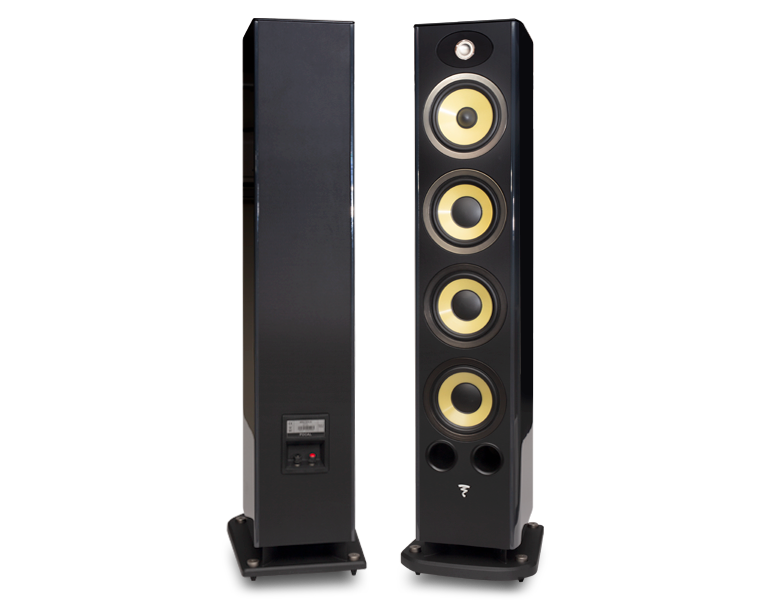
Description
The Aria K2 936 is “a revamped and unique” version of the Aria 936 ($5390/pair), Focal says, and the only Aria model to be released in a special limited edition. However, the K2 isn’t all that great a departure from the original Aria 936.
Like every Focal speaker I’ve reviewed, both versions are made in France. They share the same weight and dimensions: 64 pounds, and 42.75″H x 9″W x 13″D, or 45.25″H x 11.56″W x 14.63″D with bottom plinth (included) attached. Both cabinets are made of MDF, with nonparallel sidewalls that taper slightly inward toward the rear panel, which is just 8.25″W.
Most of the two models’ internal parts and external features are also the same: A 1ʺ inverted dome tweeter with a diaphragm of aluminum and magnesium is set into and surrounded by an oval piece of urethane that acts as a shallow waveguide, mostly to assist with horizontal dispersion. Near the bottom of the front baffle are two round ports, and on the cabinet’s underside is a third, larger port. That bottom port is what necessitates the all-metal plinth: It must be in place, to give this tall speaker a surer footing, and because the gap it opens between its top and the speaker’s underside allows air and soundwaves to exit the bottom port and radiate into the room in all directions, to fill out the low end.
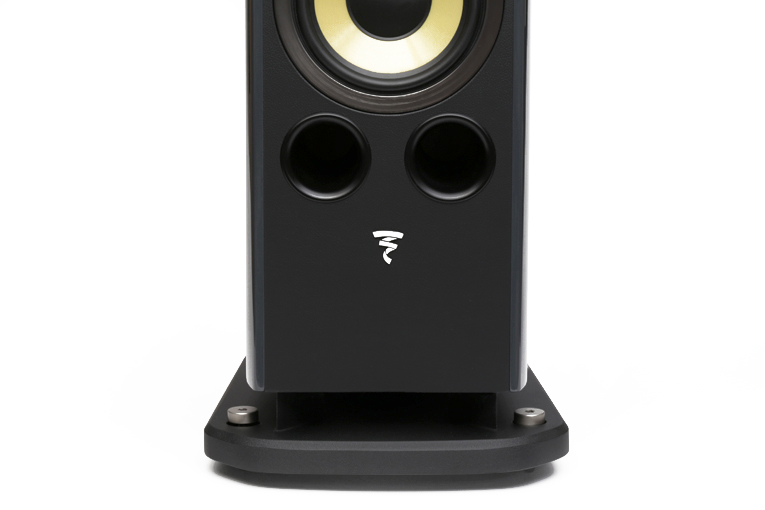
On both models, four spiked feet of metal thread through the plinth to bite the floor, to give the speaker an even firmer stance than would the plinth alone. The height of each foot can be adjusted by hand or with the supplied wrench. (Plastic endcaps for these spikes are provided for those with hard but easily damaged floors.) Both versions of the Aria 936 have a magnetically attached grille for the front baffle (I left these off for all of my listening), a single pair of binding posts on the rear panel, faux leather on the front and rear baffles, and, covering the top panel, a 1/8″-thick glass plate that adds an attractive if purely decorative touch.
Other than the $600 price gap, the key differences between the two models have to do with the finishes of the sidewalls, and the cones of the 6.5″ midrange driver and the three 6.5″ woofers. The Aria 936’s sidewalls are available in Black High Gloss paint and Prime Walnut. The Aria K2 936 is available only in gunmetal Ash Grey, a painted finish Focal uses in their top line of speakers, the Utopia models. Although the most popular speaker finishes, at least in North America, are black paint and wood veneers, I liked the look of the K2’s Ash Grey.
The standard Aria 936’s light-brown midrange and woofer cones are made from Focal’s proprietary Flax composite, used throughout the Aria line except in the K2. The Aria K2 936’s cones are the bright yellow of Focal’s K2 material, which comprises a sandwich of aramid fiber and fiberglass. K2 was also used in Focal’s Spectral 40th loudspeaker ($9990/pair, discontinued), reviewed by Diego Estan in September 2019.
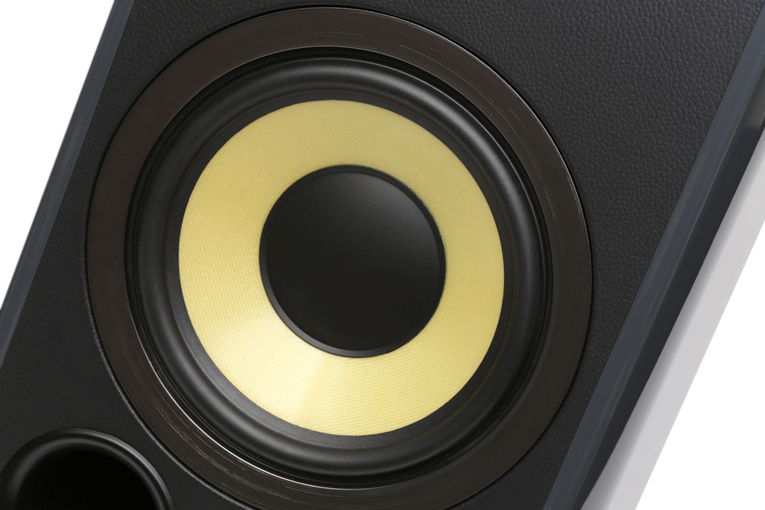
The two Aria 936es’ midrange and woofer cones may differ, but the crossover frequencies are identical: 260Hz from woofers to midrange, 3.1kHz from midrange to tweeter. Also unchanged are these specifications for both models: a frequency response of 38Hz-28kHz, ±3dB; -6dB at 32Hz; a sensitivity of 92dB/2.83V/m; and impedances of 8 ohms nominal, 2.8 ohms minimum. Only in the recommended amplification is there a slight difference: 50-300W for the Aria K2 936, up from 40-300W for the Aria 936.
Setup
My system for reviewing the Aria K2 936es was simple, starting with Purifi Audio’s Eigentakt power amplifier, which I began writing about in June 2020 and is specified to deliver 200Wpc into 8 ohms or 400Wpc into 4 ohms. The speaker cables are the ones Purifi makes and supplies with the Eigentakt: Cordial CLS 425 bulk wire terminated with banana plugs at the speaker end, Neutrik SpeakOns at the amp end. An Anthem STR preamplifier-DAC drove the Purifi via Crystal Cable Standard Diamond balanced (XLR) interconnects. All electronics were plugged into one of two Shunyata Venom HC power distributors. I used my computer’s stock power cord, and Shunyata Venom HC cords for the preamp and amp.
The sole source of music was my Asus Zenbook UX303U laptop running Windows 10, Roon, Qobuz, and Tidal, connected to the Anthem with an AmazonBasics USB link. I listened to files of varying resolutions, all stored on an attached solid-state drive.
My reference listening room is big—about 36′L x 16-18′W. I use only half of this space as a listening room, which leaves a big open area behind me. Having so much room proved vital in getting the Focals to sound their best.
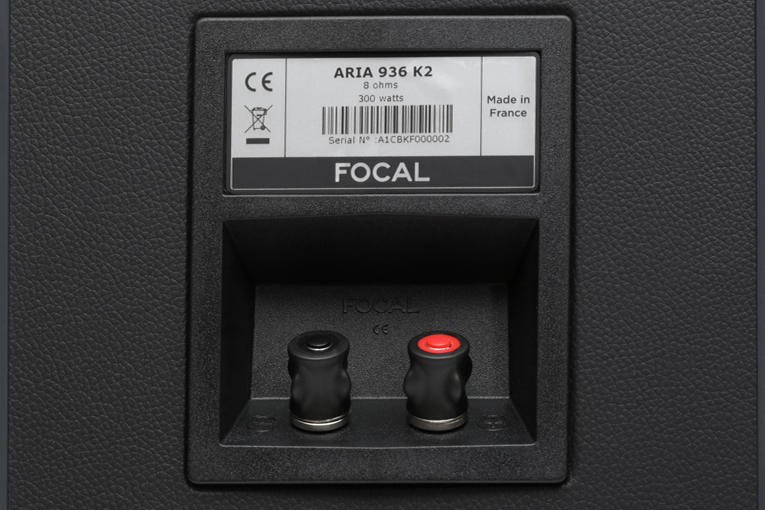
The first thing I noticed about the sound of the Aria K2 936es, as set up in the usual places I put all speakers I review, was that they were far more sensitive than the KEF LS50 Metas, by about 8dB. I knew this because for the KEFs, I typically set the Anthem’s volume control to around -35dB for a “normal” listening level. For the Focals, the volume hovered around -43dB. I kept the French floorstanders at about -60dB for background listening, whereas I’d set the KEFs to around -50dB for such listening. As I write this, we haven’t yet measured the Aria K2 936 in the anechoic chamber at Canada’s National Research Council (NRC), but I wouldn’t be surprised if its sensitivity at least comes close to its specified 92dB/2.83V/m. (We measured 83.2dB for the KEF LS50 Meta.)
I also noticed that, sitting in my usual listening chair, my ears weren’t far enough above the floor to put them on the Focals’ tweeter axes, as that chair does with most speakers I review; instead, my ears were on the level of the center of each Aria’s midrange cone: 38″ above the floor. The center of the tweeter is about 43″ high—quite a bit higher than the 36-39ʺ of the tweeters of most speakers. This helps explain why Focal recommends a listening distance of 10-12′ for both versions of the Aria 936—that puts the listener in the farfield rather than the nearfield, and gives the outputs of all five drivers of this fairly tall floorstander a better chance to cohere into a unified wavefront at the listener’s ears. So I moved the Aria K2 936es 7″ farther from my chair than I usually place speakers in my room, which put my ears 10′ from each front baffle. But I didn’t change the speakers’ distance from each other: with 10° of toe-in, the centers of their tweeters were 8′ apart.
Finally, the Aria K2 936es were properly set up. I got down to some serious listening.
Sound
When I played the 2012 remastering of Blue Rodeo’s 1989 album, Diamond Mine (16-bit/44.1kHz WAV, Atlantic), the K2 936es did a fine job of reproducing its wide, deep soundstages. In the title track, especially, lead singer Greg Keelor’s voice was positioned with reasonable solidity at the center, as it should be, and the abundant ambience around it at the beginning of the track spread way out to the sides and behind Keelor, letting me know that this was recorded in a very large space. (According to Nicholas Jennings, in an article in the April 17, 1989, issue of MacLean’s, Diamond Mine was recorded “initially in a gutted Toronto movie theatre and completed in a New Orleans apartment-studio.”) With this and other Diamond Mine tracks, the speakers also did a good job of “disappearing”—they and their positions in the room seemed to have little to do with the sound of the music I was hearing and that they were certainly reproducing. They weren’t quite as spectacular at this as the KEF LS50 Metas, which are world-beaters in that department, but they were about as good as I’ve heard from any other big floorstander at anywhere near the price.
Yet various tracks on Diamond Mine—the title track, “Now and Forever,” “God and Country”—also revealed that the Aria K2 936es’ tweeters, even above the level of my ears when seated, could sound a bit bright, if never quite too bright. However, on a scale of 1 to 5, in which 1 is too dull, 5 is too bright, and 3 is just right, the Aria K2 936es earned a 4. The KEF LS50 Metas and my reference Revel Ultima2 Salon2 floorstanders ($21,998/pair) get a solid 3 in my room. Obvious conclusion: The Focal is tipped up in the treble. But for Diamond Mine, that level of treble was still enjoyable.
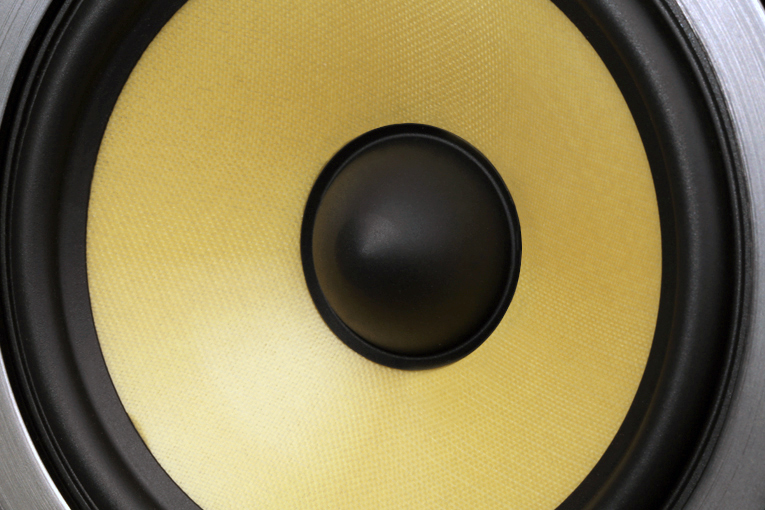
The Aria K2s’ hint of brightness wasn’t a problem with Bruce Cockburn’s wonderful, all-instrumental album Crowing Ignites (16/44.1 FLAC, True North), which has a more robust sound than Diamond Mine. The speaker’s prominent treble was still audible, but it added a lively character to Cockburn’s guitar that never teetered toward too bright.
The Cockburn album also revealed how well the outputs of all five drivers blended—I heard no hint of where the midrange cone handed off to the tweeter or woofers—and how detailed and nimble these speakers could sound. From the spare opening track, “Bardo Rush,” to the more complex mix of the album’s closer, “Bells of Gethsemane”—replete with bells, cymbals, and other percussion, all played by Cockburn—the Aria K2 936es’ lightning-quick delivery was like that of electrostatic speakers: always startlingly clean, from low volume levels to high. In fact, it was this sense of “speed,” combined with outstanding clarity at all volume levels, that endeared these speakers to me, and had me listening to this album a dozen times in two days.
To further test the Aria K2 936es’ performance at high volumes, I played “You Shook Me All Night Long,” from AC/DC’s Hells Bells (16/44.1 WAV, Atlantic), with the Anthem STR’s volume control open to -30dB. That would be reasonably loud with most speakers, but with the Focals it was really loud. The sound at that level was also exceedingly clean, leaving me with no doubt that the Focals could deliver high volumes with an effortlessness that small speakers such as the KEF LS50 Metas can’t compete with. These pretty big speakers could deliver very big sound. However, when I concentrated on Phil Rudd’s powerful drumming, to hear if it was as tight as I know it is, and how low in the bass the Focals could go, I concluded that while the Aria K2 936es could match my reference Revel Ultima2 Salon2s in bass tightness and control, they couldn’t go quite as low.
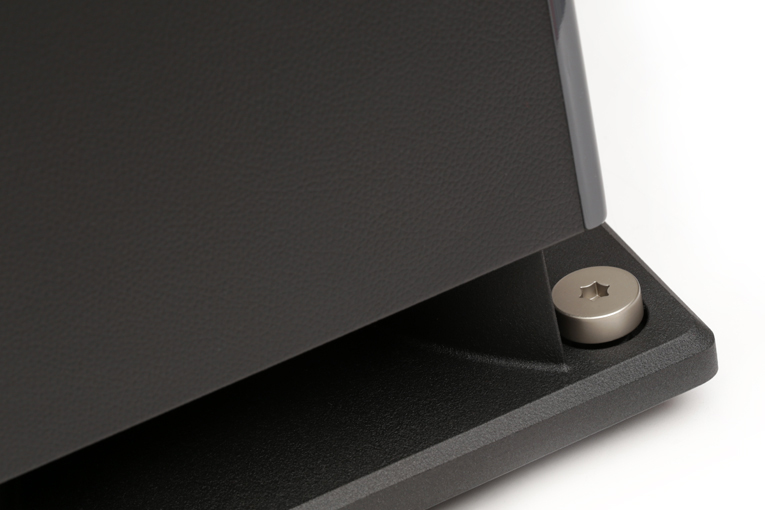
To further evaluate the Focals’ bass extension, I played the Cowboy Junkies’ The Trinity Session (16/44.1 WAV, RCA), which has strong bass output down to 20Hz. I had only to play the first few seconds of “Sweet Jane” to know that the Aria K2 936es were generating strong bass in the 30-40Hz decade, but not much below that—the room-pressuring whomp my Revels deliver when reproducing the entire bottom octave (20-40Hz) of the audioband just wasn’t there. But to be fair: While the Aria K2 936 is a big speaker, it’s not nearly as big as the Salon2, which at 53.3″H stands almost a foot higher, and costs more than three times as much.
Since its release in August 2019, I’ve played Lana Del Rey’s Norman Fucking Rockwell! (16/44.1 FLAC, Polydor) so often that I now know all its lyrics by heart. “Mariners Apartment Complex” told me pretty much the whole story of the Aria K2 936’s midrange: superclean, ultrasmooth, and amply detailed. There was still a bit of the HF emphasis I’d noted with Diamond Mine and Crowing Ignites, most evident in Del Rey’s voice and the acoustic guitar, but it wasn’t off-putting. It wasn’t the most detailed reproduction of her voice on this album that I’ve heard—that prize goes to Vivid Audio’s Giya G2 Series 2, which costs $50,000/pair. Getting almost but not quite there is more than forgivable in a speaker costing just $5990/pair. The Aria K2 936 presents its buyer with a more-than-reasonable facsimile of the best sound available.
But the title track of NFR! told me how important the right listening distance is with these speakers. When the Focals first arrived, I played this track before moving them back that last 7″. Del Rey’s voice was superclean, but with a touch of lower-midrange emphasis I hadn’t heard from other speakers I’d recently had in. I pushed the speakers back 7″, listened again, and most of that emphasis vanished. When you listen, don’t sit too close to the Aria K2 936es.
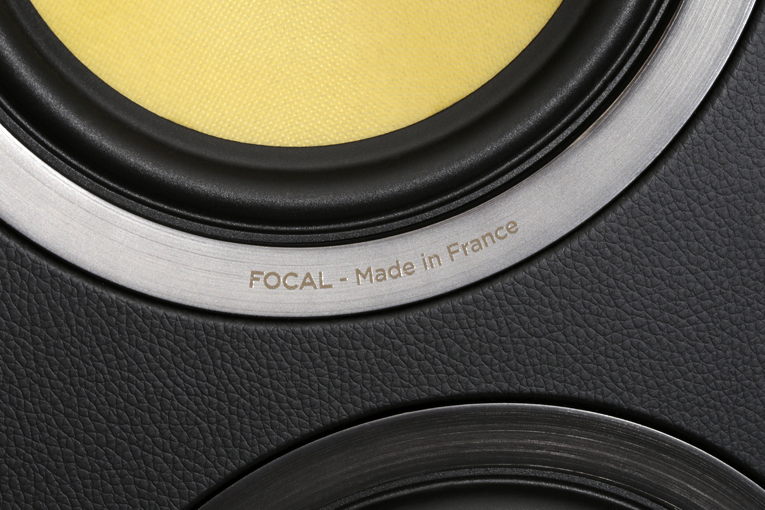
In “Love Song,” Del Rey’s close-miked voice has been recorded with a wonderful smoothness, accompanied by a gentle but impactful piano; and the electronic processing of her voice works to great effect. The voice and piano sounded rich and smooth throughout, without sounding too rich or too smooth, and the detail in the vocal effects, which I focus on intently when critically evaluating a speaker, were again very easy to hear. Beginning at 2:06, as Del Rey sings “Grab my waist, don’t waste any part,” heavy reverb is added to the last two words. Ten seconds later, reverb is added to the final word of the question “Is it safe, is it safe to just be who we are?” This reverb extends to the sides and the rear of the soundstage, punctuating these words by starkly contrasting with the sound of her voice as she sings the other words in these phrases. The Aria K2 936es displayed such details in bold relief.
Conclusion
I’m glad I’ve reviewed Focal’s Aria K2 936. This fairly large speaker was easy to drive to high volume levels, and could deliver a big, bold, effortless sound without ever sounding strained. Its bass didn’t reach down to 20Hz, but even bigger speakers at or near this price typically can’t do that—it’s why you pay big bucks for, say, my Revel Ultima2 Salon2s. And though the Aria K2 936’s treble was a bit tipped up, I never found this annoying; instead, my guess is that Focal, long known for their lively-sounding tweeters, has designed that characteristic into the Aria K2 936.
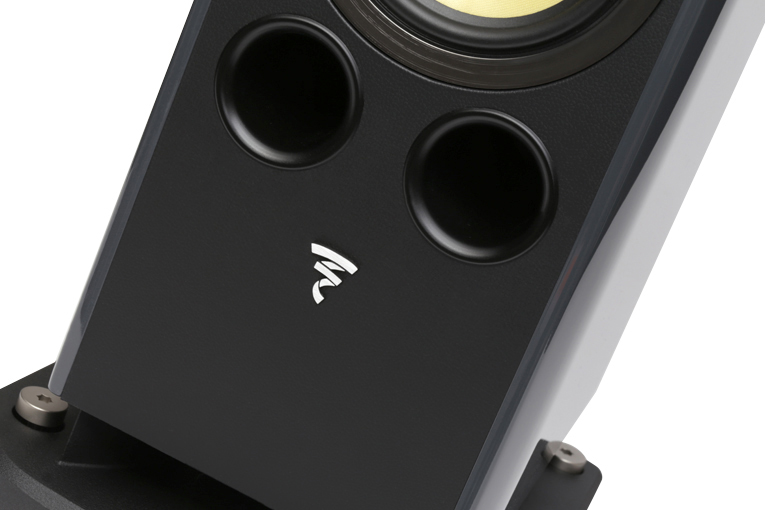
But the Aria K2 936es shone in their ability to project that big, effortless sound with the agility of a pair of electrostatic speakers, in combination with the kind of detail, particularly through the midband, that audiophiles expect from much smaller speakers. That’s why, the longer I listened, the more I thought of the Aria K2 936 as a largeish floorstander with the soul of a minimonitor. But unlike minimonitors, which, to deliver the kind of sound just described, usually work best in small spaces, the Arias needed a pretty big room in which the listener could sit at least 10′ away from them. If you have that kind of space, you can count the Aria K2 936 as among Focal’s string of winning designs.
. . . Doug Schneider
das@soundstagenetwork.com
Associated Equipment
- Speakers: Focal Diablo Utopia Colour EVO, KEF LS50 Meta, Revel Ultima2 Salon2
- Preamplifier-DAC: Anthem STR
- Power amplifier: Purifi Audio Eigentakt
- Computer: Asus Zenbook UX303U laptop running Windows 10, Roon, Tidal, Qobuz
- Digital link: AmazonBasics (USB)
- Analog interconnects: Crystal Cable Standard Diamond balanced (XLR)
- Speaker cables: Purifi Audio using Cordial CLS 425 wire
- Power distributor/conditioner: Shunyata Research Venom PS8 with Defender (2)
- Power cords: Shunyata Research Venom HC
Focal Aria K2 936 Loudspeakers
Price: $5990 USD per pair.
Warranty: Five years parts and labor.
Focal Naim America
313 Rue Marion
Repentigny, Quebec J5Z 4W8
Canada
Phone: (800) 663-9352
Website: www.focal.com





















